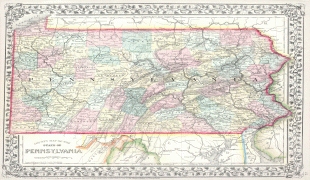Pennsylvania
 |
 |
Pennsylvania is the fifth-most populous state in the nation with over 13 million residents. It is the 33rd-largest state by area and ranks ninth among all states in population density. The southeastern Delaware Valley metropolitan area comprises and surrounds Philadelphia, the state's largest and nation's sixth most populous city. Another 2.37 million reside in Greater Pittsburgh in the southwest, centered around Pittsburgh, the state's second-largest and Western Pennsylvania's largest city. The state's subsequent five most populous cities are: Allentown, Reading, Erie, Scranton, and Bethlehem. The state capital is Harrisburg.
Pennsylvania's geography is highly diverse: the Appalachian Mountains run through the center of the state; the Allegheny and Pocono mountains span much of Northeast Pennsylvania; close to 60% of the state is forested. While it has only 140 mi of waterfront along Lake Erie and the Delaware River, Pennsylvania has more navigable rivers than any other state in the nation, including the Delaware, Ohio, and Pine Creek rivers.
Pennsylvania was founded in 1681 through a royal land grant to William Penn, son of the state's namesake; a southeast portion of the state was once part of the colony of New Sweden. Established as a haven for religious and political tolerance, the Province of Pennsylvania was known for its relatively peaceful relations with native tribes, innovative government system, and religious pluralism. Pennsylvania was one of thirteen British colonies from which the nation was formed.
Pennsylvania played a vital and historic role in the American Revolution and the ultimately successful quest for independence from the British Empire. Its largest city, Philadelphia, was the gathering place of the nation's Founding Fathers and home to much of the thinking, activism, and writing that inspired the American Revolution. Philadelphia hosted the First Continental Congress in Carpenters' Hall in 1774, and, beginning the following year, the Second Continental Congress in Independence Hall, which in 1776 unanimously adopted the Declaration of Independence, a document that historian Joseph Ellis has described as "the most potent and consequential words in American history" and which formally launched the American Revolutionary War.
On December 25 and 26, 1776, Washington secretly led a column of Continental Army troops across the Delaware River from Bucks County, launching a successful surprise attack against Hessian mercenaries at the Battle of Trenton. In 1777 and 1778, the national capital of Philadelphia fell under British control for nine months, and multiple Revolutionary War battles were fought in Pennsylvania. For six months, Washington and 12,000 Continental Army troops encamped at Valley Forge over a harsh winter with limited supplies; roughly 1,700 to 2,000 of them died at Valley Forge from disease and malnutrition.
In Philadelphia, the Second Continental Congress, on June 21, 1778, ratified the Articles of Confederation, which served as the foundation for the ultimate development and ratification of the U.S. Constitution. On December 12, 1787, Pennsylvania became the second state after Delaware, which had previously been part of Pennsylvania as the three lower counties, to ratify the Constitution. On eight separate occasions prior to the construction of Washington, D.C. as the nation's capital, a Pennsylvania city served as the nation's capital. Philadelphia served as the nation's capital on six separate occasions, including from 1775 to 1776, in 1777, twice in 1778, in 1781, and from 1790 to 1800; York and Lancaster both briefly served as the nation's capital in 1777.
During the American Civil War, Pennsylvania's 360,000 Union Army volunteers proved influential in strengthening the Union, successfully guarding the national capital of Washington, D.C., which was vulnerable following the fall of Fort Sumter, and later leading daring raids against Confederate Army strongholds in the Deep South. The bloodiest battle of the Civil War with over 50,000 casualties, and one of the Union Army's most important victories, was fought on Pennsylvania soil at Gettysburg over three days in July 1863. The Union Army's victory at Gettysburg is considered the turning point in the war, leading to the Union's preservation. President Abraham Lincoln's 271-word address dedicating Gettysburg National Cemetery on November 19, 1863, remains one of the best-known speeches in American history.
In the late 19th and 20th centuries, Pittsburgh-based U.S. Steel, Bethlehem-based Bethlehem Steel, and other Pennsylvania manufacturing companies inspired the American Industrial Revolution and contributed to the development of much of the nation's early infrastructure, including key bridges, skyscrapers, and warships, tanks, and other military hardware used in U.S.-led victories in World War I, World War II, and the Cold War. Since Pennsylvania's 1787 founding, a number of influential Pennsylvanians have contributed significantly to the nation in many fields, including the military, politics, business, scientific innovation, thought leadership, philanthropy, music, art, and sports.
Map - Pennsylvania
Map
Country - United_States
 |
 |
| Flag of the United States | |
Indigenous peoples have inhabited the Americas for thousands of years. Beginning in 1607, British colonization led to the establishment of the Thirteen Colonies in what is now the Eastern United States. They quarreled with the British Crown over taxation and political representation, leading to the American Revolution and proceeding Revolutionary War. The United States declared independence on July 4, 1776, becoming the first nation-state founded on Enlightenment principles of unalienable natural rights, consent of the governed, and liberal democracy. The country began expanding across North America, spanning the continent by 1848. Sectional division surrounding slavery in the Southern United States led to the secession of the Confederate States of America, which fought the remaining states of the Union during the American Civil War (1861–1865). With the Union's victory and preservation, slavery was abolished nationally by the Thirteenth Amendment.
Currency / Language
| ISO | Currency | Symbol | Significant figures |
|---|---|---|---|
| USD | United States dollar | $ | 2 |
| ISO | Language |
|---|---|
| EN | English language |
| FR | French language |
| ES | Spanish language |




























































































